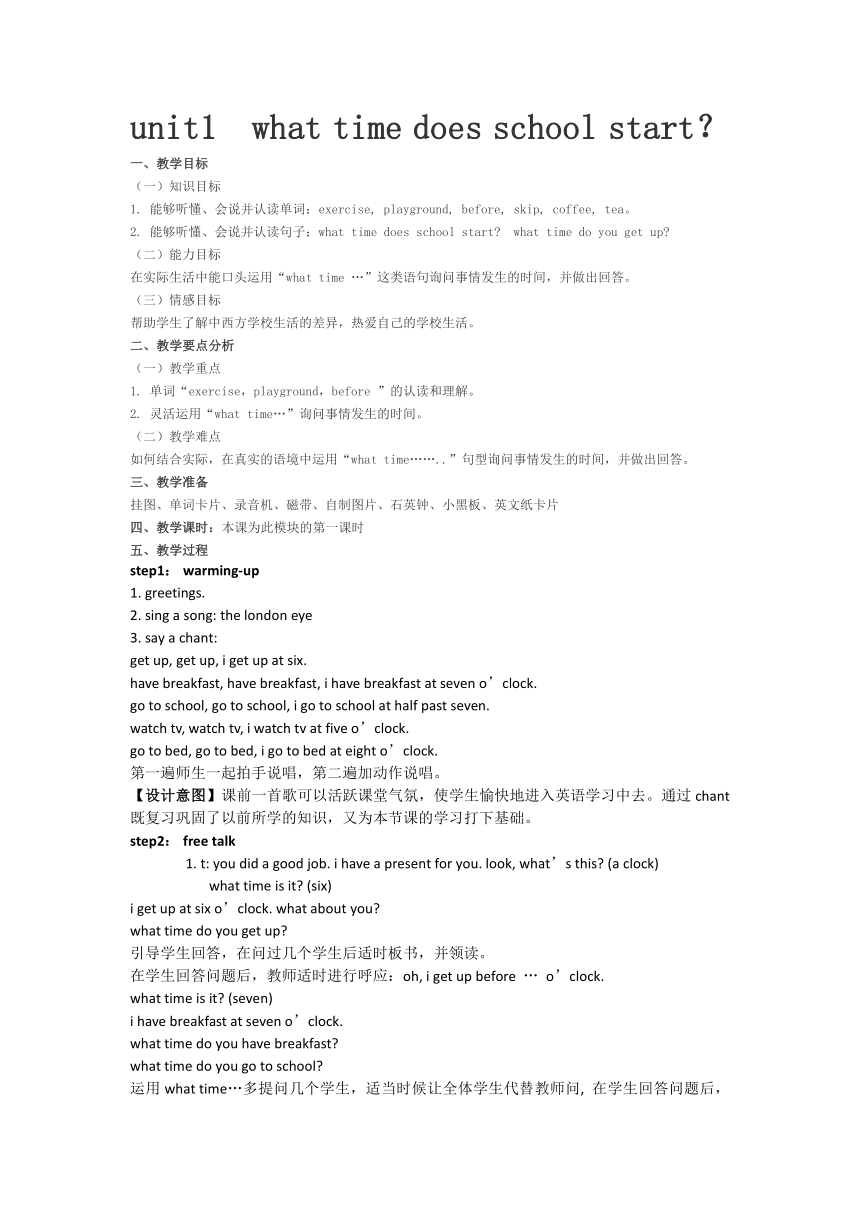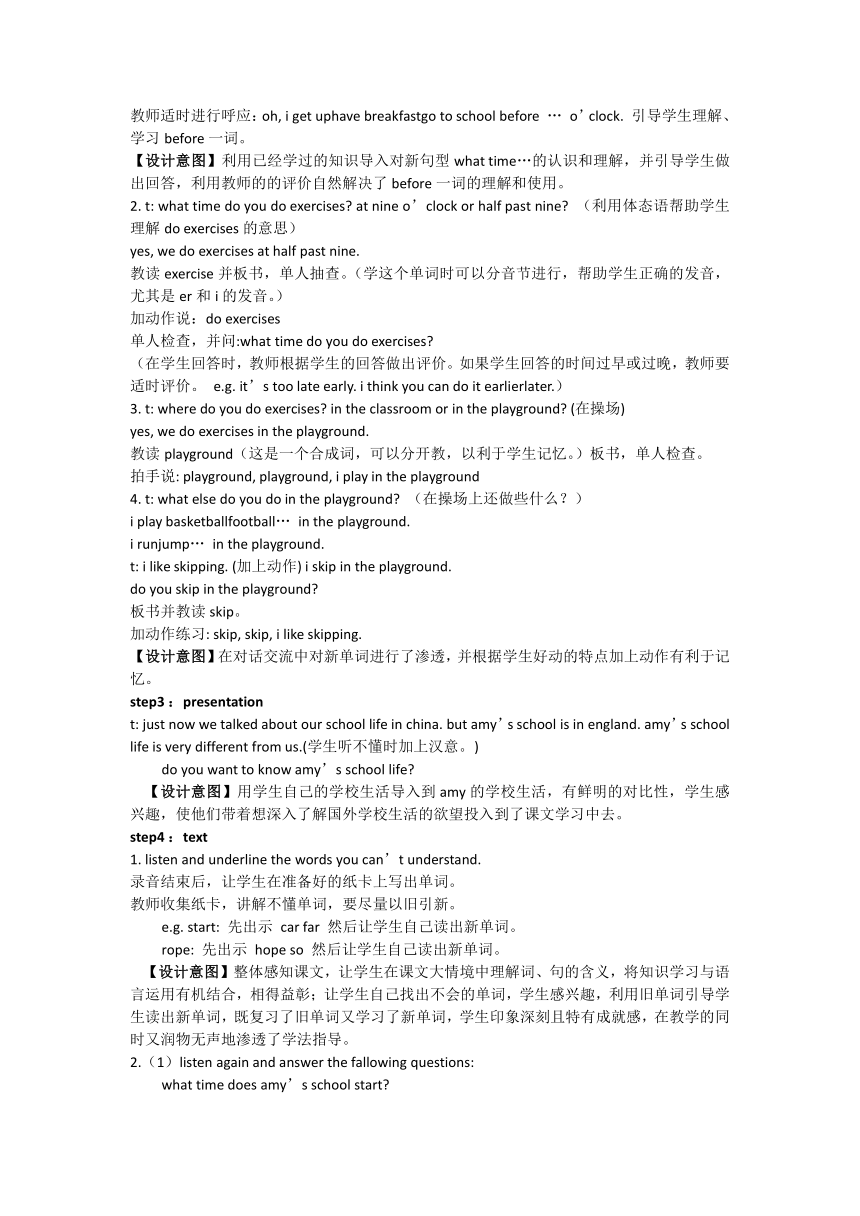Module 8 Unit 1 what time does school start 教案
文档属性
| 名称 | Module 8 Unit 1 what time does school start 教案 |

|
|
| 格式 | zip | ||
| 文件大小 | 7.8KB | ||
| 资源类型 | 教案 | ||
| 版本资源 | 外研版(三年级起点) | ||
| 科目 | 英语 | ||
| 更新时间 | 2018-08-27 11:24:57 | ||
图片预览


文档简介
unit1?what time does school start?
一、教学目标
(一)知识目标
1. 能够听懂、会说并认读单词:exercise, playground, before, skip, coffee, tea。
2. 能够听懂、会说并认读句子:what time does school start??what time do you get up?
(二)能力目标
在实际生活中能口头运用“what time …”这类语句询问事情发生的时间,并做出回答。
(三)情感目标
帮助学生了解中西方学校生活的差异,热爱自己的学校生活。
二、教学要点分析
(一)教学重点
1. 单词“exercise,playground,before ”的认读和理解。
2. 灵活运用“what time…”询问事情发生的时间。
(二)教学难点
如何结合实际,在真实的语境中运用“what time……..”句型询问事情发生的时间,并做出回答。
三、教学准备
挂图、单词卡片、录音机、磁带、自制图片、石英钟、小黑板、英文纸卡片
四、教学课时:本课为此模块的第一课时
五、教学过程
step1:?warming-up
1. greetings.
2. sing a song: the london eye
3. say a chant:
get up, get up, i get up at six.
have breakfast, have breakfast, i have breakfast at seven o’clock.
go to school, go to school, i go to school at half past seven.
watch tv, watch tv, i watch tv at five o’clock.
go to bed, go to bed, i go to bed at eight o’clock.
第一遍师生一起拍手说唱,第二遍加动作说唱。
【设计意图】课前一首歌可以活跃课堂气氛,使学生愉快地进入英语学习中去。通过chant既复习巩固了以前所学的知识,又为本节课的学习打下基础。
step2:?free talk
?????????????? 1. t: you did a good job. i have a present for you. look, what’s this? (a clock)
???????????????????????what time is it??(six)
i get up at six o’clock. what about you?
what time do you get up?
引导学生回答,在问过几个学生后适时板书,并领读。
在学生回答问题后,教师适时进行呼应:oh, i get up before … o’clock.
what time is it? (seven)
i have breakfast at seven o’clock.
what time do you have breakfast?
what time do you go to school?
运用what time…多提问几个学生,适当时候让全体学生代替教师问, 在学生回答问题后,教师适时进行呼应:oh, i get uphave breakfastgo to school before … o’clock. 引导学生理解、学习before一词。
【设计意图】利用已经学过的知识导入对新句型what time…的认识和理解,并引导学生做出回答,利用教师的的评价自然解决了before一词的理解和使用。
2. t: what time do you do exercises? at nine o’clock or half past nine? (利用体态语帮助学生理解do exercises的意思)
yes, we do exercises at half past nine.
教读exercise并板书,单人抽查。(学这个单词时可以分音节进行,帮助学生正确的发音,尤其是er和i的发音。)
加动作说:do exercises
单人检查,并问:what time do you do exercises?
(在学生回答时,教师根据学生的回答做出评价。如果学生回答的时间过早或过晚,教师要适时评价。 e.g. it’s too late early. i think you can do it earlierlater.)
3. t: where do you do exercises? in the classroom or in the playground? (在操场)
yes, we do exercises in the playground.
教读playground(这是一个合成词,可以分开教,以利于学生记忆。)板书,单人检查。
拍手说: playground, playground, i play in the playground
4. t: what else do you do in the playground? (在操场上还做些什么?)
i play basketballfootball… in the playground.
i runjump… in the playground.
t: i like skipping. (加上动作)?i skip in the playground.
do you skip in the playground?
板书并教读skip。
加动作练习: skip, skip, i like skipping.
【设计意图】在对话交流中对新单词进行了渗透,并根据学生好动的特点加上动作有利于记忆。
step3?:presentation
t: just now we talked about our school life in china. but amy’s school is in england. amy’s school life is very different from us.(学生听不懂时加上汉意。)
?????? ?do you want to know amy’s school life?
?? 【设计意图】用学生自己的学校生活导入到amy的学校生活,有鲜明的对比性,学生感兴趣,使他们带着想深入了解国外学校生活的欲望投入到了课文学习中去。
step4?:text
1. listen and underline the words you can’t understand.
录音结束后,让学生在准备好的纸卡上写出单词。
教师收集纸卡,讲解不懂单词,要尽量以旧引新。
??????? e.g.?start: 先出示 car?far 然后让学生自己读出新单词。
??????? rope: 先出示 hope?so 然后让学生自己读出新单词。
?? 【设计意图】整体感知课文,让学生在课文大情境中理解词、句的含义,将知识学习与语言运用有机结合,相得益彰;让学生自己找出不会的单词,学生感兴趣,利用旧单词引导学生读出新单词,既复习了旧单词又学习了新单词,学生印象深刻且特有成就感,在教学的同时又润物无声地渗透了学法指导。
2.(1)listen again and answer the fallowing questions:
??????? what time does amy’s school start?
what time does amy get up?
does amy go to school by bus?
does amy do exercises every morning?
?????? ?听录音前,先让学生读懂问题,录音结束后,师生共同订正答案。
?amy’s school starts at nine o’clock. 重点读一下 starts
?amy gets up at half past nine.?重点读一下 gets
(2)t: what time does your school start? (板书)
??????? 学生回答,并板书。
(3)教师领读板书的两组句型,和小黑板板书的问题及答案。
??? 【设计意图】在了解了课文大意的前提下,让学生带着问题再次听录音,通过回答问题反馈学生对课文的掌握情况。
(4)work in pairs: act out the dialogue.
3. listen, point and repeat the text.
【设计意图】再次听录音,关注学生的语音语调。
step5:?practice
1.???? play a game:
t: look here, i have some wonderful pictures. let’s enjoy the pictures. ok? i’ll ask one of you to choose a picture and the others ask him or her a question with “what time…”(加上动作,帮助学生理解。)
?????? 学生抽出一张图片(照片可以参照课本活动3)之后,其他的学生用what time …询问他,这位学生做出回答。也可以是教师抽图片,男生问,女生答;分组问,分组答。
????? 【设计意图】抽图片这个小环节,学生比较感兴趣,都想来试试,在玩的同时有效地练习了句型what time…。
2. group work小记者: 请两位同学扮演采访与被访者,参看表格中的提示进行采访示范,也可发挥想象自定采访内容。教师可以根据本班情况安排同桌,或邻桌或小组内互相采访。
what time…?
?
name
get up
do exercises
go home?
?
?
?
?
?
?
?
?
?
?
?
?
?
【设计意图】 小记者的活动,可以充分体现学生的主体地位,自主采访,既运用了所学语言,又增加了学生之间的友谊。
step6:?summary
结合实际,点明句型的实际应用。
this class, we have learned how to describe the time about our daily life. such as…
step7 homework
??????? 1. listen to the tape and read the text.
??????? 2. 在小组内,依照课文谈论自己理想中的学校生活。下节课,我们进行“理想生活大比武”活动,评选出我们的“最理想学校生活”。
??????? 教师可以多提供一些例子:
??????? my school starts at nine o’clock.
???????i can get up at 8 o’clock.
?????? we can read books at the noon.
???????we can play football in the playground in the afternoon.
???????…
板书设计
moudle8?? school
unit1?what time does school start?
?
???what time do you get up???
????i get up at six o’clock.???
??????what time does school start?
????????????my school starts at eight o’clock.
?
?
六、教学反思?本课设计以学生为主体,各种活动充分调动学生的积极性,通过各种不同的活动形式,让学生真正的参与到课堂中,注重教育学生集体合作的意识,并在一定程度上让学生了解了西方国家教育方式的不同。
? 通过这节课的设计,我能在以后的教学中认识到学生主体的重要性,争取让学生多多参与,感受到英语的乐趣!
一、教学目标
(一)知识目标
1. 能够听懂、会说并认读单词:exercise, playground, before, skip, coffee, tea。
2. 能够听懂、会说并认读句子:what time does school start??what time do you get up?
(二)能力目标
在实际生活中能口头运用“what time …”这类语句询问事情发生的时间,并做出回答。
(三)情感目标
帮助学生了解中西方学校生活的差异,热爱自己的学校生活。
二、教学要点分析
(一)教学重点
1. 单词“exercise,playground,before ”的认读和理解。
2. 灵活运用“what time…”询问事情发生的时间。
(二)教学难点
如何结合实际,在真实的语境中运用“what time……..”句型询问事情发生的时间,并做出回答。
三、教学准备
挂图、单词卡片、录音机、磁带、自制图片、石英钟、小黑板、英文纸卡片
四、教学课时:本课为此模块的第一课时
五、教学过程
step1:?warming-up
1. greetings.
2. sing a song: the london eye
3. say a chant:
get up, get up, i get up at six.
have breakfast, have breakfast, i have breakfast at seven o’clock.
go to school, go to school, i go to school at half past seven.
watch tv, watch tv, i watch tv at five o’clock.
go to bed, go to bed, i go to bed at eight o’clock.
第一遍师生一起拍手说唱,第二遍加动作说唱。
【设计意图】课前一首歌可以活跃课堂气氛,使学生愉快地进入英语学习中去。通过chant既复习巩固了以前所学的知识,又为本节课的学习打下基础。
step2:?free talk
?????????????? 1. t: you did a good job. i have a present for you. look, what’s this? (a clock)
???????????????????????what time is it??(six)
i get up at six o’clock. what about you?
what time do you get up?
引导学生回答,在问过几个学生后适时板书,并领读。
在学生回答问题后,教师适时进行呼应:oh, i get up before … o’clock.
what time is it? (seven)
i have breakfast at seven o’clock.
what time do you have breakfast?
what time do you go to school?
运用what time…多提问几个学生,适当时候让全体学生代替教师问, 在学生回答问题后,教师适时进行呼应:oh, i get uphave breakfastgo to school before … o’clock. 引导学生理解、学习before一词。
【设计意图】利用已经学过的知识导入对新句型what time…的认识和理解,并引导学生做出回答,利用教师的的评价自然解决了before一词的理解和使用。
2. t: what time do you do exercises? at nine o’clock or half past nine? (利用体态语帮助学生理解do exercises的意思)
yes, we do exercises at half past nine.
教读exercise并板书,单人抽查。(学这个单词时可以分音节进行,帮助学生正确的发音,尤其是er和i的发音。)
加动作说:do exercises
单人检查,并问:what time do you do exercises?
(在学生回答时,教师根据学生的回答做出评价。如果学生回答的时间过早或过晚,教师要适时评价。 e.g. it’s too late early. i think you can do it earlierlater.)
3. t: where do you do exercises? in the classroom or in the playground? (在操场)
yes, we do exercises in the playground.
教读playground(这是一个合成词,可以分开教,以利于学生记忆。)板书,单人检查。
拍手说: playground, playground, i play in the playground
4. t: what else do you do in the playground? (在操场上还做些什么?)
i play basketballfootball… in the playground.
i runjump… in the playground.
t: i like skipping. (加上动作)?i skip in the playground.
do you skip in the playground?
板书并教读skip。
加动作练习: skip, skip, i like skipping.
【设计意图】在对话交流中对新单词进行了渗透,并根据学生好动的特点加上动作有利于记忆。
step3?:presentation
t: just now we talked about our school life in china. but amy’s school is in england. amy’s school life is very different from us.(学生听不懂时加上汉意。)
?????? ?do you want to know amy’s school life?
?? 【设计意图】用学生自己的学校生活导入到amy的学校生活,有鲜明的对比性,学生感兴趣,使他们带着想深入了解国外学校生活的欲望投入到了课文学习中去。
step4?:text
1. listen and underline the words you can’t understand.
录音结束后,让学生在准备好的纸卡上写出单词。
教师收集纸卡,讲解不懂单词,要尽量以旧引新。
??????? e.g.?start: 先出示 car?far 然后让学生自己读出新单词。
??????? rope: 先出示 hope?so 然后让学生自己读出新单词。
?? 【设计意图】整体感知课文,让学生在课文大情境中理解词、句的含义,将知识学习与语言运用有机结合,相得益彰;让学生自己找出不会的单词,学生感兴趣,利用旧单词引导学生读出新单词,既复习了旧单词又学习了新单词,学生印象深刻且特有成就感,在教学的同时又润物无声地渗透了学法指导。
2.(1)listen again and answer the fallowing questions:
??????? what time does amy’s school start?
what time does amy get up?
does amy go to school by bus?
does amy do exercises every morning?
?????? ?听录音前,先让学生读懂问题,录音结束后,师生共同订正答案。
?amy’s school starts at nine o’clock. 重点读一下 starts
?amy gets up at half past nine.?重点读一下 gets
(2)t: what time does your school start? (板书)
??????? 学生回答,并板书。
(3)教师领读板书的两组句型,和小黑板板书的问题及答案。
??? 【设计意图】在了解了课文大意的前提下,让学生带着问题再次听录音,通过回答问题反馈学生对课文的掌握情况。
(4)work in pairs: act out the dialogue.
3. listen, point and repeat the text.
【设计意图】再次听录音,关注学生的语音语调。
step5:?practice
1.???? play a game:
t: look here, i have some wonderful pictures. let’s enjoy the pictures. ok? i’ll ask one of you to choose a picture and the others ask him or her a question with “what time…”(加上动作,帮助学生理解。)
?????? 学生抽出一张图片(照片可以参照课本活动3)之后,其他的学生用what time …询问他,这位学生做出回答。也可以是教师抽图片,男生问,女生答;分组问,分组答。
????? 【设计意图】抽图片这个小环节,学生比较感兴趣,都想来试试,在玩的同时有效地练习了句型what time…。
2. group work小记者: 请两位同学扮演采访与被访者,参看表格中的提示进行采访示范,也可发挥想象自定采访内容。教师可以根据本班情况安排同桌,或邻桌或小组内互相采访。
what time…?
?
name
get up
do exercises
go home?
?
?
?
?
?
?
?
?
?
?
?
?
?
【设计意图】 小记者的活动,可以充分体现学生的主体地位,自主采访,既运用了所学语言,又增加了学生之间的友谊。
step6:?summary
结合实际,点明句型的实际应用。
this class, we have learned how to describe the time about our daily life. such as…
step7 homework
??????? 1. listen to the tape and read the text.
??????? 2. 在小组内,依照课文谈论自己理想中的学校生活。下节课,我们进行“理想生活大比武”活动,评选出我们的“最理想学校生活”。
??????? 教师可以多提供一些例子:
??????? my school starts at nine o’clock.
???????i can get up at 8 o’clock.
?????? we can read books at the noon.
???????we can play football in the playground in the afternoon.
???????…
板书设计
moudle8?? school
unit1?what time does school start?
?
???what time do you get up???
????i get up at six o’clock.???
??????what time does school start?
????????????my school starts at eight o’clock.
?
?
六、教学反思?本课设计以学生为主体,各种活动充分调动学生的积极性,通过各种不同的活动形式,让学生真正的参与到课堂中,注重教育学生集体合作的意识,并在一定程度上让学生了解了西方国家教育方式的不同。
? 通过这节课的设计,我能在以后的教学中认识到学生主体的重要性,争取让学生多多参与,感受到英语的乐趣!
同课章节目录
- Module 1
- Unit 1 Did you come back yesterday?
- Unit 2 We bought ice creams.
- Module 2
- Unit 1 What did you buy?
- Unit 2 How much cheese did you buy?
- Module 3
- Unit 1 Where did you go?
- Unit 2 Daming took a photo of his father.
- Module 4
- Unit 1 Mum bought a new T-shirt for me.
- Unit 2 What's the matter with Daming?
- Module 5
- Unit 1 There are only nineteen crayons
- Unit 2 There are forty.
- Module 6
- Unit 1 You can play football well.
- Unit 2 He ran very fast.
- Module 7
- Unit 1 He can't see.
- Unit 2 This little girl can't walk.
- Module 8
- Unit 1 What time does your school start?
- Unit 2 Yesterday I went to Sam and Amy's school.
- Module 9
- Unit 1 Are you feeling bored?
- Unit 2 I feel happy.
- Review Module
- Unit 1
- Unit 2
- Module 10
- Unit 1 He was in the kitchen.
- Unit 2 Don't shout, please!
- 旧版资料
- Module 1 London
- Module 2 Shopping
- Module 3 At the Weekend
- Module 4 Possession
- Module 5 In Class
- Module 6 Self-assessment
- Module 7 Community
- Module 8 School
- Module 9 Feelings
- Module 10 Manners
- Review Module
